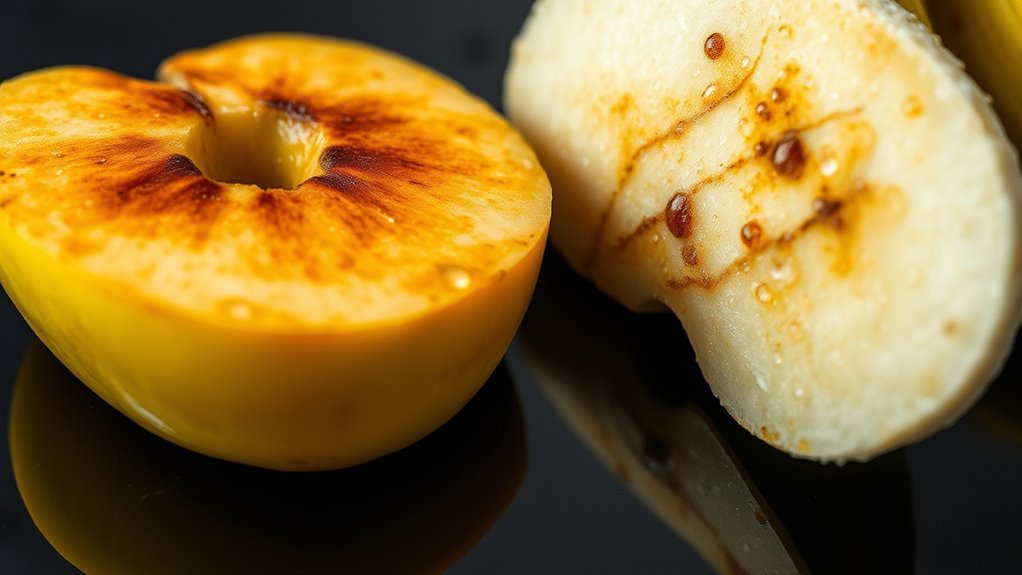When you cut fruit, you break open cells, releasing enzymes called polyphenol oxidase (PPO) that react with oxygen. This chemical reaction produces brown pigments called melanins, giving the fruit a brown color. Factors like temperature, oxygen exposure, and fruit type influence how quickly this happens. To understand why this browning occurs and how to slow it down, there’s more behind the chemistry that you might find interesting to explore.
Key Takeaways
- Cutting fruit exposes its phenolic compounds to enzymes like polyphenol oxidase (PPO).
- PPO catalyzes the oxidation of phenols to quinones in the presence of oxygen.
- Quinones react with amino acids, forming brown melanin pigments that cause discoloration.
- Increased oxygen exposure and higher temperatures accelerate the browning process.
- Applying acids or antioxidants can inhibit enzymatic activity and slow browning.
The Enzymatic Reaction Behind Browning
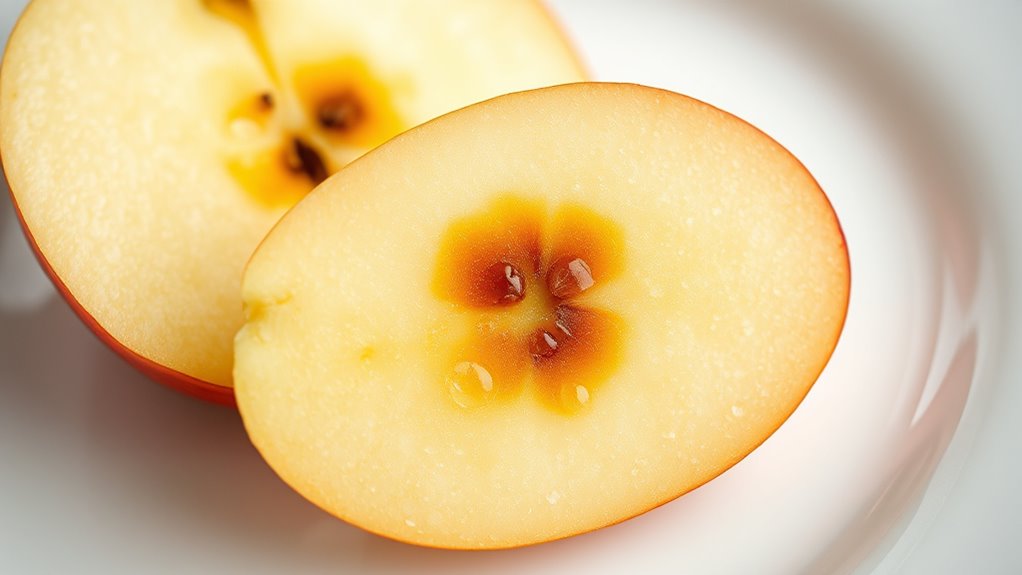
Enzymatic browning occurs when enzymes like polyphenol oxidase (PPO) catalyze the oxidation of phenolic compounds in fruit and vegetable tissues. When you cut or damage produce, cell compartments break down, bringing enzymes into contact with phenols. This process is a natural defense mechanism in plants, but it can negatively impact the appearance, flavor, and nutritional value of your food. The PPO enzyme then facilitates the transfer of electrons from phenolic compounds to oxygen, producing quinones. These quinones quickly react with other molecules, forming brown, pigmented polymers that cause browning. Oxygen availability is vital, as the reaction needs it to proceed. Factors like temperature, pH, moisture, and light influence how fast this process happens. Understanding the enzymatic process helps you find ways to control or slow browning, especially through proper storage techniques that limit oxygen contact and enzyme activity. Additionally, some antioxidant compounds can inhibit enzyme activity and reduce browning. For example, applying acids or reducing agents can alter enzyme activity by changing the pH level, thereby slowing down the browning process.
Key Chemicals Involved in the Process
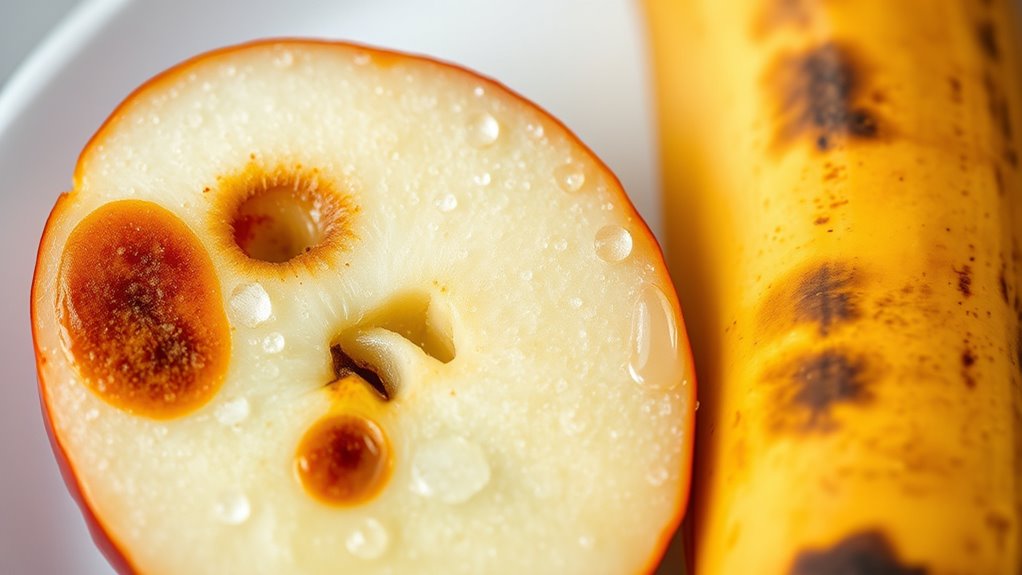
Several key chemicals drive the browning process in cut fruit. The enzyme polyphenol oxidase (PPO) oxidizes polyphenols, naturally present compounds in fruits like apples. Oxygen is essential; it activates PPO and promotes the conversion of polyphenols into o-quinones, which are unstable intermediates. Understanding enzymatic reactions helps explain why controlling these chemicals can prevent browning. Additionally, the presence of antioxidants can slow down or inhibit the browning process by neutralizing reactive oxygen species. These o-quinones react with amino acids, forming brown melanins that cause the discoloration. Without oxygen, the enzyme can’t function, slowing or preventing browning. Polyphenols provide the raw material, while PPO acts as the catalyst, and oxygen enables the entire reaction. Interestingly, some fruits naturally contain higher levels of phenolic compounds, making them more prone to browning. The level of polyphenols can vary significantly between different fruit varieties, affecting their susceptibility to browning. Other chemicals, like sulfur dioxide, ascorbic acid, and citric acid, inhibit this process by denaturing PPO or creating unfavorable conditions. These chemicals are used in commercial and home remedies to keep cut fruits looking fresh longer. Understanding the chemical reactions involved offers insights into effective methods for preserving fruit freshness.
Fruits Most Affected by Browning

Many fruits are especially prone to browning once they’re cut or damaged, making it a common concern for both consumers and food producers. Apples are highly susceptible because of their high polyphenol oxidase (PPO) activity, which rapidly causes browning. Polyphenol oxidase is the enzyme primarily responsible for the enzymatic browning process in these fruits. Pears also brown quickly due to similar enzymatic reactions. Bananas develop dark spots over time, especially when exposed to air, because of their high phenolic content. Peaches and apricots are delicate and tend to brown rapidly when bruised or sliced, affecting their appearance and quality. These fruits’ susceptibility is linked to their enzyme levels and flesh composition, which accelerate browning upon damage. Managing browning in these fruits is vital to maintaining their visual appeal and reducing food waste.
Factors Influencing the Rate of Browning
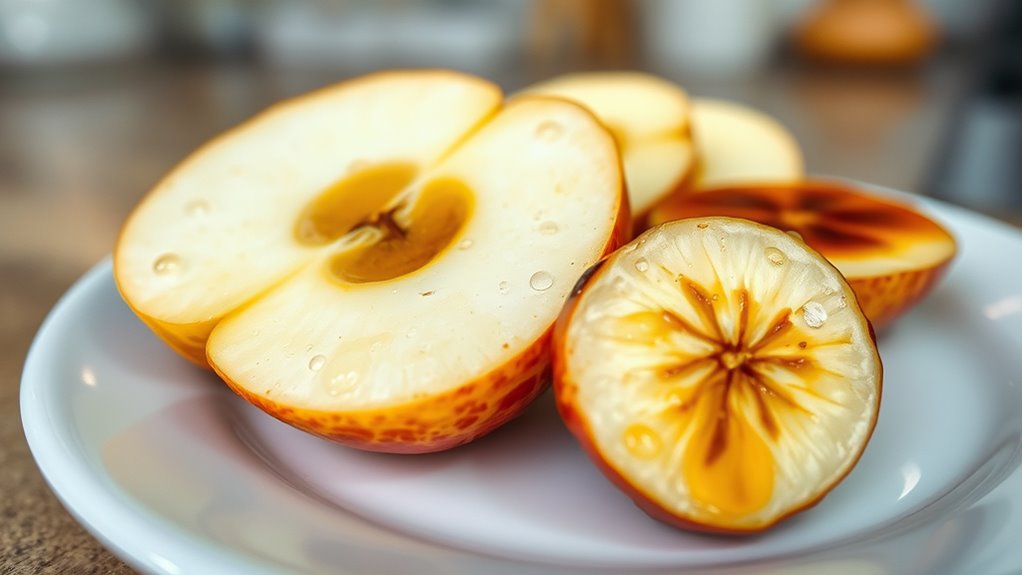
The rate of browning in cut fruit is primarily influenced by environmental and physical factors that affect enzymatic activity and chemical reactions. Higher oxygen levels accelerate enzymatic oxidation of phenolics, with increased surface area exposed to air speeding up quinone formation. The presence of oxygen is a key driver in the browning process, as it directly interacts with enzymatic pathways. Vacuum packaging and inert gases like nitrogen reduce oxygen contact, slowing browning. Elevated temperatures boost PPO enzyme activity up to a certain point, while cold storage (4-8°C) markedly decreases it. Blanching above 70°C denatures PPO, preventing browning, whereas freezing inactivates enzymes temporarily. Temperature control is essential because it directly influences enzyme activity rates. Temperature regulation can be achieved through controlled refrigeration and processing methods. Additionally, the use of antioxidant agents, such as ascorbic acid, can help slow down oxidative browning by interfering with enzyme activity. Time also plays a critical role, with longer exposure increasing browning, especially for highly reactive fruits. Furthermore, the presence of air filtration technologies in storage environments can help minimize airborne contaminants that might catalyze oxidation processes.
Methods to Prevent and Slow Down Browning
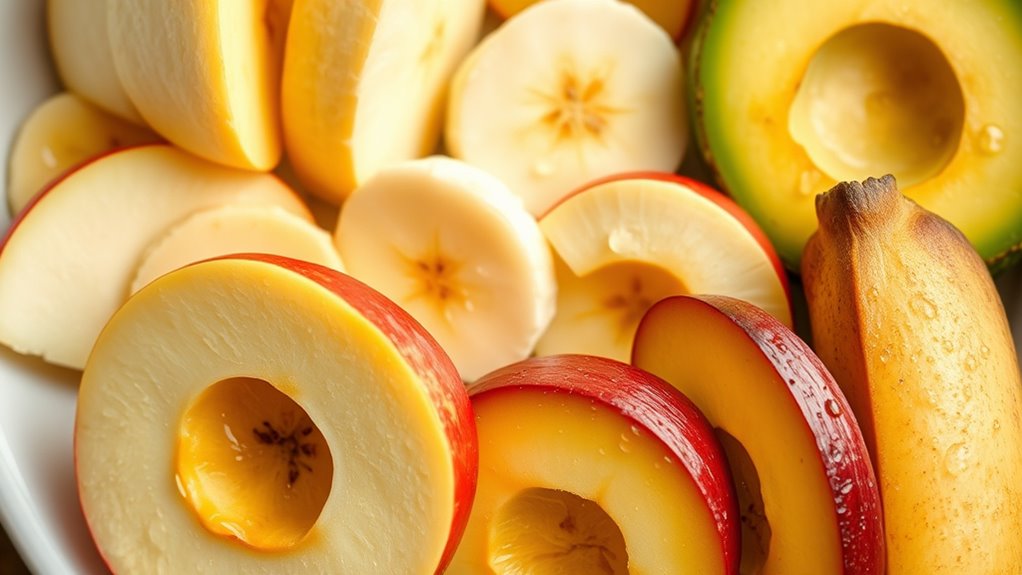
To effectively slow down or prevent browning in cut fruits, applying various methods can make a significant difference. One simple approach is to use lemon juice or citric acid solutions, which inhibit oxidation thanks to their acidity and vitamin C content. Additionally, oxidation process can be slowed by reducing the fruit’s exposure to oxygen, which is why airtight storage is effective. Using antioxidants like ascorbic acid can further help in preserving the color and texture of cut fruits. Soaking fruits in soda water (seltzer) can also help preserve color and texture. Commercial anti-browning agents like Fruit-Fresh® are effective when used according to instructions.
Using lemon juice or citric acid can effectively slow browning in cut fruits.
Storing cut fruits in airtight containers in the refrigerator minimizes oxygen exposure, slowing enzymatic reactions. Proper storage conditions, including maintaining a cold temperature, further help to delay browning. Using proper storage techniques ensures maximum freshness and color retention for longer periods. Non-soaking methods, such as covering with a damp paper towel soaked in acidic juice or securing pieces with a rubber band, reduce oxygen contact. Additionally, quick refrigeration and controlling storage conditions further delay browning, keeping your fruits fresh and appealing longer. Maintaining an awareness of food safety practices around pets can also prevent accidental ingestion of harmful substances.
Frequently Asked Questions
Can Browning Be Reversed Once It Occurs?
Once browning occurs, reversing it isn’t really possible. You might try treatments like acids or antioxidants, but they won’t restore the original color because the chemical changes are permanent.
Physical removal or coating can slow further discoloration, but they won’t undo what’s already happened. To keep fruit looking fresh, it’s best to act quickly with preventive measures like lemon juice or airtight storage, since reversal isn’t feasible after browning sets in.
Are There Natural Ways to Prevent Browning?
Think of browning like a slow-burning fire that you want to stop before it spreads. You can prevent it naturally by applying lemon juice or vitamin C, which act like fire extinguishers, cutting off oxygen that fuels the reaction.
Soaking fruit in these antioxidants, wrapping it tightly, or using extracts from green tea or thyme can help keep your fruit vibrant and fresh longer, without resorting to chemicals.
Does Browning Affect the Nutritional Value of Fruit?
Browning in fruit can slightly impact its nutritional value. When enzymes oxidize polyphenols, it reduces antioxidants like vitamin C and other phenolic compounds, potentially lowering health benefits.
However, the overall calorie, fiber, and mineral content stay mostly unchanged. So, while browning may diminish some antioxidants, it doesn’t make the fruit unsafe or substantially less nutritious, especially if you consume it soon after it browns.
How Long Does It Take for Sliced Fruit to Brown?
Imagine your sliced fruit as a freshly painted canvas. In just 15-30 minutes, the first brushstrokes of oxidation appear, turning it slightly dull.
Over the next 1-2 hours, the colors deepen into brown shades as pigments form. By 3-6 hours, the painting is fully transformed, and the browning becomes permanent.
To slow this process, you can use lemon juice or refrigeration, preserving your fruit’s vibrant appearance longer.
Is Enzymatic Browning Harmful to Health?
Enzymatic browning isn’t harmful to your health. It produces non-toxic melanins and doesn’t substantially reduce nutrients like carbs or fiber.
While it may affect antioxidants slightly, the fruit remains safe to eat, unless spoilage signs like mold or bad odor appear.
To keep your fruit safe and appealing, store it properly, add lemon juice, or choose varieties bred for less browning.
Conclusion
Think of your fruit as a freshly painted canvas, vibrant and full of life. When it turns brown, it’s like the colors fading away, caused by a natural enzymatic reaction. But don’t worry—you can slow down this process with simple tricks. By understanding the chemistry behind browning, you can keep your fruit looking fresh and appealing, just like preserving a masterpiece before time takes its toll. Keep your fruit colorful and inviting!
